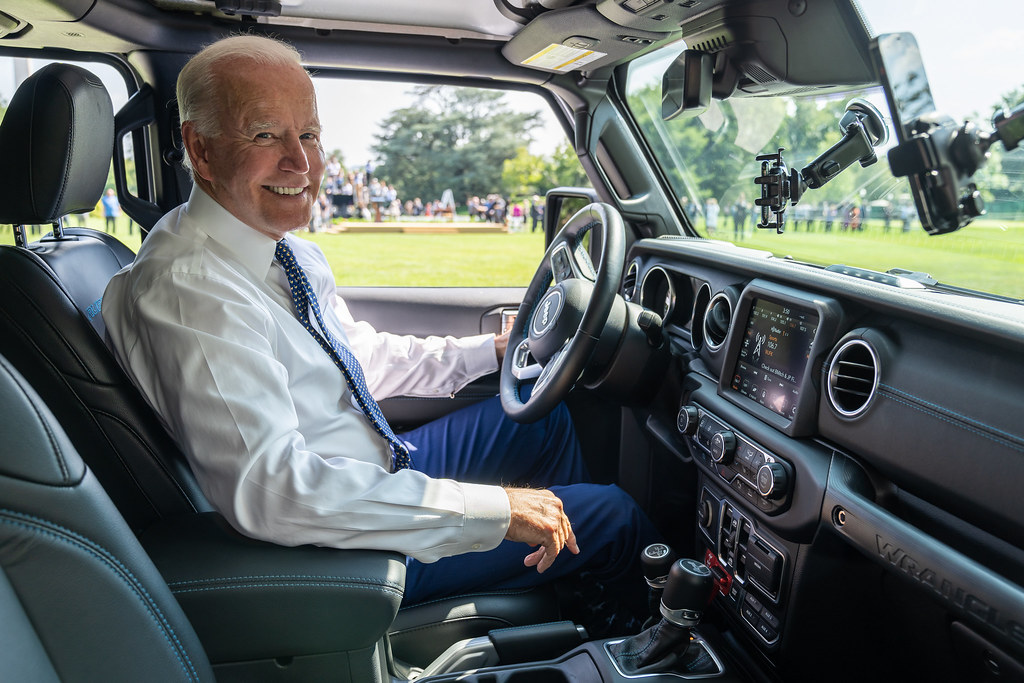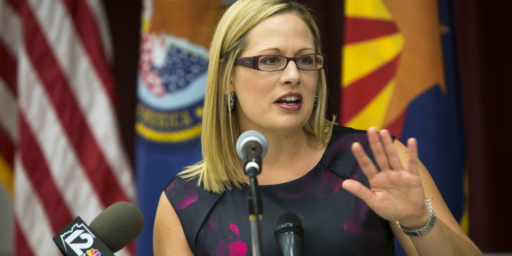Biden Settling for Smaller Spending Package
The President seems to have persuaded the progressives in his party to settle for half a loaf.

After months of refusing to see that they don’t have enough votes within their own caucus to pass a massive expansion of the welfare state, President Biden is working to persuade the Sanders-Jayapal wing to settle for less.
WaPo (“Biden tells Democrats that package of up to $1.9 trillion should be new target of talks“):
President Biden told Democrats during a private meeting Tuesday that he believed they could secure a deal on a new tax-and-spending proposal between $1.75 trillion and $1.9 trillion, far less than some in the party initially sought, even as some lawmakers later maintained it still would allow them to accomplish broad swaths of their vast economic agenda.
The early outline — shared at least with liberal lawmakers in the House — appeared to offer one potential avenue for the White House to broker a truce among Democrats’ warring left-leaning and moderate factions. Four people familiar with Biden’s comments confirmed the early details, requesting anonymity to describe the negotiations.
The potential new price range marks a significant reduction from the $3.5 trillion that some Democrats initially pursued under a budget agreement chiefly brokered by Sen. Bernie Sanders (I-Vt.) earlier this year. But it is closer to the number that centrists, especially Sen. Joe Manchin III (D-W.Va.), had outlined in recent months as they sought steep cuts to Democrats’ spending plans. Manchin and Sanders met Tuesday for the second time in two days after the two sparred with each other over the weekend.
By the White House’s calculations, a package up to $1.9 trillion would allow them to accomplish some of their most significant priorities. That includes at least some expansion of Medicare to offer new benefits to seniors, the introduction of universal prekindergarten, and billions of dollars to address climate change, the sources said, cautioning that many of the details must still be worked out.
But slimming down the package also is sure to force Democrats to make some sacrifices. The path put forward by the White House could extend new, expanded child tax credit payments recently adopted by Congress, but perhaps for only one additional year, three of the sources said. It would offer new money to make housing more affordable, yet far less than Democrats once envisioned. And it would provide paid leave, except only four weeks of benefits, rather than the 12 weeks some had once proposed, according to one of the people in the room.
Some congressional sources cautioned that many of the ideas aired by the White House remain in flux, reflecting considerable work still on the horizon to craft a deal and sell such a scaled-back package to an increasingly fractious Democratic caucus. Biden also did not broach the issue of how to finance the new spending, leaving unresolved the fight over his proposal to raise taxes on wealthy Americans and corporations. He previously pledged it would be paid for in full.
CNN (“Biden discusses $1.9 trillion top line for economic package and tells Democrats free community college is out“) adds:
President Joe Biden informed House progressives Tuesday afternoon that the final bill to expand the social safety net is expected to drop tuition-free community college, a major White House priority, according to multiple sources familiar with the matter.
[…]
Moreover, he indicated that the child tax credit — a key Democratic priority — would likely be extended for one additional year, much shorter than what many in their party wanted, one of the sources said. The child tax credit will also likely be means tested, keeping with what Manchin had wanted.
Biden also indicated to the group that they would reduce the proposed funding for so-called homecare for the elderly and disabled — down to less than $250 billion, sources said. Democrats had wanted to keep the funding at $400 billion.[…]
The President said they plan to keep an expansion of Medicare, which includes hearing, dental and vision — in line with what the progressives want.
Most of the internecine fight seems to be over the size of the package and the symbolism surrounding that rather than over the actual policies. Manchin is skeptical of some of the environmental programs and, especially, universal free community college. The latter, especially, has always seemed an odd hill to die on. It makes little sense to subsidize community colleges from the federal coffers, let alone for those of us who can afford to send our kids to school. Still, it was a program Biden campaigned on pretty heavily.
The compromise solution seems odd from a policy standpoint but makes some sense from a political view. Rather than prioritize the most popular initiatives, the plan seems to be to do partial funding for all of them but community college. Presumably, that allows progressives to claim that they delivered on these programs, even though funding them for a single year is enormously wasteful given start-up costs. Still, there may be a “camel’s nose” philosophy at work here, with a hope that the programs will prove sufficiently popular to make not funding them in the next cycle difficult. That’s unlikely to be true, though, given the likelihood of a Republican Congress in 2023.
Regardless, it’s baffling that it has taken this long to acknowledge what has been obvious from the start: there simply aren’t the votes for the $3.5 billion package.
POLITICO (“Biden bets his agenda on the inside game“) notes that the President is purposefully working behind the scenes rather than taking to the bully pulpit.
As Democrats on Capitol Hill brace in anticipation of a brutal midterm, Biden is spending an extraordinary amount of time and political capital behind the scenes to convince them to rally around a common framework for social and climate spending. His congressional huddles have accelerated, from phone calls on the White House veranda to one-on-one and group meetings — including two high-stakes Tuesday sit downs with moderates and progressives. He’s dialing up old friends to take their temperature about how his presidency is really fairing far beyond the Beltway.
[…]
As Biden has worked on lawmakers in private — sometimes not putting a hard stop on his schedule so as not to stifle progress — he’s largely, though not entirely, resisted riskier public pressure campaigns that could backfire and are viewed as against his nature.
Often, Biden has had just a single public event each day. Occasionally, there’s been no public interfacing at all. Eight times since Labor Day, the daily guidance issued by the White House has included only private meetings with Biden.
A planned barnstorming of the country to sell the Build Back Better platform this summer was overshadowed by the chaotic U.S. withdrawal from Afghanistan. And congressional uncertainty amid infighting among Democrats on opposite poles of the party has overshadowed continuing trips by Cabinet officials and commandeered the media narrative in Washington.
While Biden has held public events around the agenda, he has not done a formal press interview on it since Labor Day. On Wednesday, he will take a trip to his hometown of Scranton, Pa., to discuss the benefits of the legislative proposals, and on Thursday he will participate in a town hall broadcast on CNN.
“The President won the most votes in history running on his Build Back Better agenda, unveiled the formal proposal in his first address to a joint session of Congress, and has made his case across the country ever since – along with his cabinet – which is deeply resonating with the American middle class,” White House spokesman Andrew Bates said.
[…]
Still, inside the White House, the lower-key strategy has been seen as a necessity: Democrats have such slim congressional majorities that Biden, Senate Majority Leader Chuck Schumer and Speaker Nancy Pelosi have essentially no margin for error. That has put far more of the president’s focus on convincing a relatively small number of lawmakers to agree to details of the package, rather than using his time to sell policies that the general public supports.
Chief among that small number of lawmakers are Manchin and Sinema, who remain resistant to the range of $1.9 trillion to $2.2 trillion that Biden and progressive lawmakers have discussed as a compromise top line for the social spending bill.
“I’m told that they’ve given signs on the parking spaces for these two senators at the White House, that they’re there so often,” Senate Majority Whip Dick Durbin (D-Ill.) said of Manchin and Sinema. “This president has been engaged from the start, in working with all the leaders, and particularly with those two senators.”
[…]
Another explanation for the approach was baked in long ago. Biden is a 36-year veteran of the Senate with a heightened sense of his own negotiating instincts and abilities to move major legislation through the chamber. A self-admitted schmoozer, he has avoided doing much to shame Manchin and Sinema, preventing many details from their conversations and about his own preferences from spilling into public view.
“There’s a lot of complaining about what the message has been on this package, but when you’re trying to fight for every vote, the coverage inevitably becomes about the process and numbers,” said John Podesta, a top aide to former Presidents Barack Obama and Bill Clinton and a major climate activist. “When you are inside talking one-on-one to members trying to convince people to stay with you or come on board it’s very hard to create a press environment which is different from what they’ve got.”
As messy and slow-going as this all has been, the approach seems to be working. While it remains to be seen whether Biden can get Manchin and Sinema on board with this compromise package, just about everyone else is saying the right thing in public. Back to WaPo:
Liberal-leaning Democrats, meanwhile, offered some early praise for what they heard Tuesday. They acknowledged some of the cuts while stressing that many of their policy priorities in health care, education and social spending appear to remain intact.
“All our priorities are there in some way, shape or form,” said Rep. Pramila Jayapal (D-Wash.), the leader of the Congressional Progressive Caucus.
The early outlines of a deal came on a day when Democrats pledged to muscle past the political sniping and policy feuds that have ensnared Biden’s economic agenda for months.
“There was universal, universal agreement in that room, that we have to come to an agreement, and we got to get it done and want to get it done this week,” Senate Majority Leader Charles E. Schumer (D-N.Y.) said earlier in the day, a lengthy party lunch he later described as “spirited.”
“The pace has picked up,” Schumer said. “The desire to get it done is strong.”
Seeking to bridge the gap, Biden began Tuesday by meeting with Jayapal and other lawmakers. Exiting the discussion at the White House, Jayapal said she felt “very good” that the “majority” of the programs backed by the left-leaning bloc would be in the final deal.
“The president is the inspirer, he is the closer, he is the convincer, he is the mediator-in-chief. He really is doing a phenomenal job,” she said.
Jayapal and other members of her bloc said that there is still hope for a final package to include an expansion to Medicare to cover dental, vision and hearing benefits as well as a new program that provides universal prekindergarten for children. Other sources later said that Biden had signaled other critical health care programs, including some money for elder care, extended insurance tax credits and fixes to Medicaid also remain in the mix.
Given how much schmoozing of Manchin and Sinema the President has done, one presumes he’s confident that they’ll sign off on this. We shall soon see.





‘Massive expansion of the welfare state.’ That’s the decades worth of framing that Dems have never found a way to counter. It’s to their detriment. That very phrase immediately makes me think of the theme song to ‘All In the Family’, a show that encapsulated a viewpoint that I find borderline odious.
Interested to see how the various camps within the Democratic caucus slap lipstick onto the piglets that represent what they ‘won’, in this whole exercise. They’ll need to hurry onto the next thing. If they don’t have a good midterm result, then the country will continue to stagnate (as we’ve been doing, by any number of indicators, for at least 25 years).
@Long Time Listener: There are parts of the expanded social welfare program, including adding vision and dental coverage to Medicare, that I support. But I don’t know what else you’d call it.
We’re going to have to pay for all of this anyways. Those whining about the bill don’t seem to realize the cost still need to be accounted for down the line – childcare must still be paid for, infrastructure not built or fixed now will cost even more in the future and the child tax credit is incredibly popular. We’ll still have to spend the 3.5T and very likely more since putting things off only makes them more expensive.
What’s more, the Great Resignation has shown Americans aren’t interested in going back to things the way they were and want a better deal. Better pay, better working conditions, things other countries have like paternity leave and paid childcare. Means-testing the thing that will help get people back to work means *dun dun DUN!!!* they likely won’t to stay under the test limit. It’s on of those duh moments that goes to show idiots like Manchin and Sinema are kissing the wrong asses; $15hr or more is coming because that’s what it will take to get people to work these empty jobs so businesses are gonna take the hit anyways. GOP stubbornness is setting a path towards a future they don’t want as they’re too cheap to pay the penny for prevention now to avoid the pound of cure later.
@James Joyner:
Available Social Assets (ASA). Welfare not only has a negative connotation from years of GOP BS but it also implies caretaking or dependence. By labeling them as Assets available for a citizen to use, it makes it clear these are things that are yours to use if you need or want them. Not handouts but what is owed to you as a member of our society in your current state. SS, Medicaid, Medicare, SNAP, unemployment insurance, etc – all exist as part of the support network a society needs for its members to function. Whether you use one or more of the options, it should be clear that everyone is coming to the same table; if you are entitled to SS “because you paid into it”, someone else is entitled another program for the same reason (even if it’s a symbolic penny).
Americans have been poisoned against their own benefits to the point the word “entitlement” (means something you are owed by legal rights) is now a dirty word implying greed or unearned taking. Reframe it as Social Assets or Social Options, perhaps even Future Social Investments.
Well, at least I got what I wanted, and that’s all that matters. All the rest o’ you po’ folk can go take yo’ squalling babies and what not and raise ’em yo’ se(l)ves. I’m not payin fo’ it. Y’heah??
@James Joyner:
Catching up with other first world economies?
@Scott F.:
You know, many third world countries do have paid family leave and paid sick leave. perhaps not adequately enough, but it’s there.
@James Joyner:
I’d call it “long overdue investments in American health, wealth, and quality of life instead of continued massive giveaways to corporations and thd rich.”
But I’m not beholden to the corporate media’s Reagan-era framing and right wing narratives. So.
So, have the House progressives said that they’re cool with this, and that they’ll vote for the infrastructure bill, which they have previously said they would vote against unless they got to vote for a $3.5T reconciliation bill? Or is the immediate outcome that the infrastructure bill is dead unless enough Republicans support it? The infrastructure bill passed months ago in the Senate with enough Republican support to defeat a filibuster, but I don’t remember reading anything about whether there’s support from any House Republicans.
The camel’s nose is the best we’re going to get for a lot of this. But that’s been pretty effective in the past. Republicans are better at stopping new entitlements/benefits than they are at killing existing ones. See: Social Security, Medicare, Obamacare, food stamps.
You beat me to posting on this, but my basic response is: shockingly, legislation has to be negotiated (including public posturing) and that we won’t know whether “Dems were in disarray” until this whole thing plays out (and it isn’t done yet).
The photograph you used fascinates me. Clearly, it’s meant to show Joe Biden “in the driver’s seat”. But what vehicle is this? The shifter has two knobs instead of the one I’m used to. And there are multiple smartphone holders on the windshield, too. Is this maybe The Beast – a presidential limo?
I’m with Steven. I assumed that there was a negotiation in progress. PLUS, a little drama where progressives get mad at Joe Manchin, because he needs those headlines for back home.
@Jay L Gischer:
It’s a Jeep Wrangler Rubicon.
It’s not the size of the package, it’s what you do with it. Child tax credit and climate are the big two — I don’t love the child tax credit being cut to a one year extension and the means testing, and it’s too early for me to read about the climate stuff.
I don’t trust the “moderate” Dems at all, though, and think we should rejoin the bills. Let the bipartisan bill be an amendment to the reconciliation bill, so everyone can get their bipartisan vote.
@Mu Yixiao: Thanks. Sorry for veering OT, but …
What is a “clean car event” and why is Biden driving a V8 during one?
I mean, I love Jeeps. I used to own one until it got totalled while I was sitting at a stop light. I’m not sure I see a V8 in my future, though.
Honestly, an off-roading EV seems like it would work great.
@Steven L. Taylor:
Indeed. A professor of mine once referred to politics as being the art of the possible (I’m sure he didn’t invent the phrase, but for my experience it originated with him). That has always stuck with me. The reality is that Dems just do not control enough of the legislature to get all that the various constituencies in the party would like. These people have to go back and get reelected, and there are some who just can’t vote for what was originally proposed if they want to keep their seats. Achieving something is pretty much always better than being obstinate & achieving nothing.
HL92: Agree with this point. I do wonder if the president has ever gone to the ‘neediest’ of the D caucus and said “Certainly you can count votes as well as I can. If you want X piece(s) of legislation, the price is Y number of votes. Can’t get R votes? Then, go out into the hinterland and flip their seats. You don’t have the votes, right now. Go get me the seats. Sell your story and get me the seats.”
‘Coffee is for closers.’
@Jay L Gischer:
My guess is that it’s a showcase of low-emission vehicles. And… could that be the new electric Jeep he’s in?
Oh… and the 2 “shifters”. One is gear case the other is 2/4L/4H. I’d forgotten about that from mine (it looked different).
@Jay L Gischer:..What is a “clean car event” and why is Biden driving a V8 during one?
Maybe they looked for a 1981 Caddy but none were available.
Seems like I remember the Edsel pitched as the car of the future too.
1958 Edsel Skyliner Hardtop Convertible
@HarvardLaw92:
The flip of this is that Dems need to get more Dems elected. If they had a 5 seat majority in the senate they could tell Manchin and Sinema to pound sand.
@HarvardLaw92: I do fully agree that the continued existence of the human species is outside the realm of the possible.
@Scott F.: Alas, one person’s First World country to catch up with is another’s Socialist Hellhole. (But I’m not suggesting ANY NAMES, just observing a pattern I’ve NEVER been able to control.)
@Mu Yixiao: (Commenting on caption)
The Jeep Wrangler Rubicon counts as a “clean car?” What universe did THAT auto show happen in?
@Jay L Gischer: “Honestly, an off-roading EV seems like it would work great.”
I agree! You can trailer it back and forth to the off-roading events on the low boy of your Freightliner.
@Just nutha ignint cracker:
This one. Meet the Jeep Wrangler 4XE Rubicon.
@Mu Yixiao: Ah! Thanks. The web doesn’t show that car as a first, or second or third… choice.
@Mu Yixiao: You know, when I googled “Jeep Wrangler Rubicon” I got no inkling that it came in an electric model. But “electric jeep wrangler” got me right there.
Just looked at interior photos and yep, that’s the one.
Well, that is welcome news.
@KM: So you wanted me to make up new vocabulary rather than using the ordinary English word for thing I was describing?
@Scott F.: Again, I support large parts of this. That doesn’t make it not a welfare state. Or able to attract the votes of 50 Democratic Senators.
@Dude Kembro: We had a cabinet department called Health, Education, and Welfare from 1953-1979, at which time we separated Education and Health and Human Services into two departments.
Why?
This canard exists among conservatives that we simply cannot do things that other countries do all the time – like healthcare and education and care packages to new mothers.
I know that we only do things when there’s money to be made, but I’m continually baffled that nobody can see past this quarter’s revenue to take a longer view.
@Jay L Gischer:
Those also come (or did anyway, may have changed) with a clean diesel option (the whole particulate filter / catalyst / urea thing) as well. Between those and having gotten rid of the vast majority of the sulfur that used to be in the fuel, I’m told that those are pretty green engines from an emissions standpoint. Maybe it was one of those?
@HarvardLaw92: “Those also come (or did anyway, may have changed) with a clean diesel option”
Is clean diesel actually a thing? I remember a few car companies were pushing it — mostly those owned by Volkswagen — and of course it all turned out to be a fraud. But I don’t know if others really did come up with a clean diesel technology, which was overshadowed by the fraud, or if it was always a cynical marketing ploy like “clean coal.”
@James Joyner:
I’m delighted you “support large parts” of the reconciliation package, as there is nothing being proposed that I think would pass as radical. My point remains the same – it is loaded to use “a massive expansion of the welfare state” to describe a bill that tries to respond to decades of neglect in social programs that has the US falling behind other advanced economies in how we treat our people. Would you call a very large budget to fix your roof, shore a crumbling foundation, install a chair lift for your grandmother, and upgrade your WiFi “a massive expansion” of your house?
@wr:
Best I can tell, if they’re working as they’re supposed to work (ie no VW style funny business), they’re pretty clean. They have a particulate filter which traps about 99% of the particles in the exhaust, and then a catalyst system which fixes the nitrogen in the exhaust problem by breaking it down with urea into straight nitrogen gas. The sulfur (acid rain) thing they dealt with by getting rid of the vast majority of the sulfur in the fuel. I recently stood next to one (a BMW) and couldn’t tell it was a diesel. No sooty exhaust and diesel smell. It was pretty impressive.
@Jay L Gischer: I wasn’t even aware that Jeep had a v8 as every single wrangler etc I’ve seen in the last 40 or so years had 6 or 4 cylinders. Excluding the modified ones.
@HarvardLaw92: Yeah when the owner keeps the urea tank full it’s hard to tell it’s a diesel.
@Matt:
I’ve been told that they’ll just shut themselves and refuse to operate if they run out of the stuff, but that’s anecdotal tbh. I haven’t actually seen it happen and I don’t own one.
@HarvardLaw92: They are supposed to refuse to start with an empty DEF tank. Modern street diesels are also not supposed to “roll coal” either..
@Matt:
True. No system in the world can overcome being deliberately disabled.